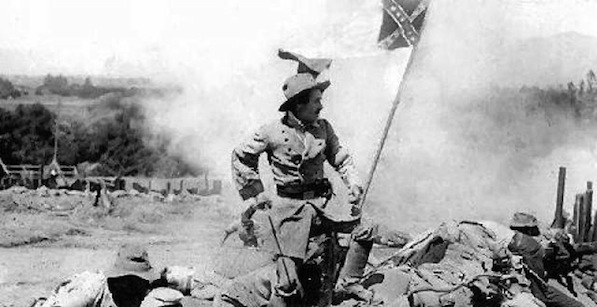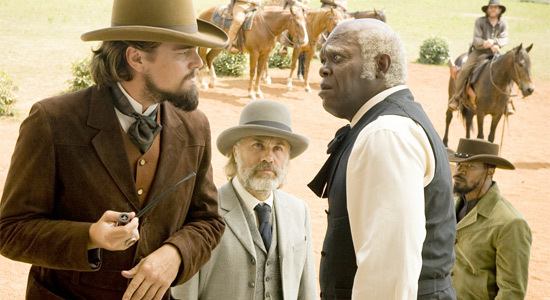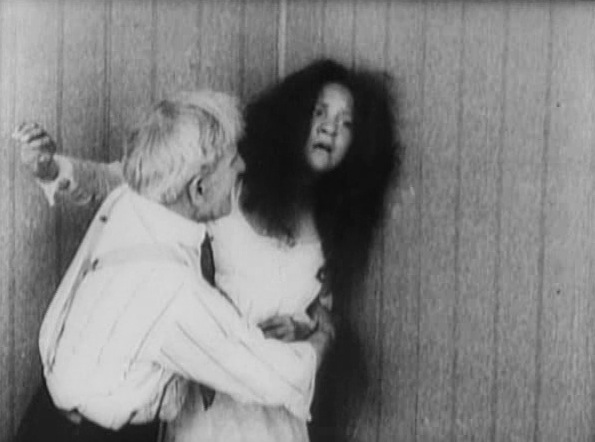Like the proverbial bad penny, D. W. Griffith’s 1915 epic about the Civil War, Reconstruction and the heroism of the Ku Klux Klan just keeps coming back to our film historical discourse. Most recently The Birth of a Nation was returned forcefully to our consciousness when Quentin Tarantino, discussing his 2012 film Django Unchained with Harvard professor Henry Louis Gates, Jr., mentioned the bit part that director John Ford played in the second half of Griffith’s film. “John Ford puts on a Klan uniform [in The Birth of a Nation], rides to black subjugation,” Tarantino says, by way of explaining why for him, Ford exemplifies everything racist and retrograde about the American Western. This in turn encouraged critic Kent Jones to pen an exceptionally detailed rebuttal of sorts, wherein he meticulously reexamines the question of race and otherness in Ford’s cinema, finding many progressive (if historically limited) impulses that Tarantino’s broadside glossed over. Although Ford’s appearance as a Klansman in Birth of a Nation was mentioned only tangentially in this discussion, it is wielded rhetorically like the ultimate evidentiary brickbat, a charge on par with being associated with Leni Riefenstahl. Interestingly, Tarantino refrains from indicting Raoul Walsh, who also appears in Griffith’s film. He has a much larger role, that of John Wilkes Booth.
It is of course not surprising that The Birth of a Nation remains such a raw nerve. It is a primal trauma in American cinema, a major achievement in the consolidation of film grammar and the visual language of white superiority. Griffith, whose artistic dream was to articulate cinema with the moral vision of Victorian literature, undertook Birth as his first long film, and did this through film dialectics that even Eisenstein admired. He negotiated interiors and exteriors, massive crowds and chamber-drama intimacy, generalized populations and synecdochal family representatives, and eventually even accommodated the supernatural within his expansive vision. Birth does this, when you look at it today, in rather clumsy but essentially legible ways, articulating cinematic space as a set of coherent units. We have all been told, endlessly, that this is why Griffith’s film is “important.”
But when we look at it today, there are some very interesting things to observe in it, formally as well as morally. And these aspects of Birth take us to the heart of the problem of its contemporary meaning. But by “contemporary meaning,” I don’t mean to suggest that we reduce Birth to rank presentism, to ignore its historical context and just be heartily offended by it from the point of view of current mores. It’s a given that most of what The Birth of a Nation depicts is disgusting and would be repudiated by all but the most virulent bigots. But we do have to consider what purposes the film can be put to today, if any. What meanings can it generate, aside from the sense of smug superiority in the modern viewer? Michel Foucault has said, “Knowledge is not made for understanding; it is made for cutting.” What Griffith’s film needs to tell us today is: Are form and content separable? Or does the vile ideology of the film infiltrate its most basic structural innovations?
There are ways in which the overlap between form and racism is fairly obvious. Griffith’s famous cross-cutting, for example, dominates the final twenty minutes of Birth, as we see multi-county legions of the South Carolina KKK assemble and rush to the rescue as mixed-race Lt. Gov. Silas Lynch (George Siegmann) plans to abscond with the young Elsie Stoneman (Lillian Gish) and force her to marry him. The rhythms of the galloping Klansmen, along with Lynch’s apelike behavior, make it clear that we’re supposed to root for the White Knights to arrive on time. But even more than this, we can see a facet of Griffith’s directorial style that seems to favor group affiliation and racial encoding, in much subtler ways.
Much is made of the pantomime approach one sees in silent films. (Roberta Pearson, in her 1992 book Eloquent Gestures, referred to this as the “histrionic mode,” as opposed to the later “verisimilar mode” of film acting.) Birth of a Nation is no exception. Here, Griffith plays it up if anything, particularly in terms of the “blacks” (who are of course played by white actors in blackface). They not only ham it up; they behave like wild animals. Silas Lynch bugs his eyes and grabs Elsie like a cross between Dr. Caligari and a crazed gorilla, and Elsie’s father’s dark-skinned maid/girlfriend Lydia (Mary Alden) widens her eyes, rubs her head and body, and begins to twitch every time she learns of new rights that African Americans will have in the post-Civil War era. When she is alone, her rapture is nothing short of orgasmic. When compared with the South Carolina legislature scene, during which newly elected black congressmen drink, howl and dig at their bare feet, we can see that the histrionic mode—a formal aspect of 1915 silent cinema—is being pushed to the very limits of its naturalist rhetoric and into a ghoulish Expressionism. The South has been overrun by monsters, and this is conveyed not only through the storyline but through a very specific application of visual performance codes.
Another formal trope that dominates The Birth of a Nation is the aforementioned dialectic between the epic and the intimate, and this is actually a place where Griffith inscribes racism within the very form of the film. As with several other of his longer films, Birth employs domestic family drama as pure synecdoche, and the two key families in the narrative—the Camerons of the South and the Stonemans of the North—are more iconic than individuated. In fact, Griffith’s blatant preference for a certain kind of actor (thin, muscular, with dark wavy hair) and actress (winsome, kewpie-doll type) often makes his protagonists difficult to tell apart. During points of crisis, such as on the battlefield or during a home siege, there are hardly enough perceptual cues to keep the characters straight. This matters little, however. Griffith’s is a cinema of the deed and not the doer.
However, one can really observe his mastery (and that of ace cinematographer Billy Bitzer) in his epic outdoor scenes. Usually shot in either long or extreme long shot, these sequences of battles or riots are crisp and expansive, relegating the human participants to the status of features of a landscape, engaged in practices that are almost natural in their inevitability. Granted, Griffith will pause now and then to single someone out, as when he shows the Union and Rebel troops squaring off on the field of battle and has the Confederate colonel raise the white flag for a second to offer a wounded Union soldier a drink of water. But mostly, swarms of bodies clash as atomized yet singular forces. And so, in the second half of the film, when Negro militias have taken over Piedmont, SC, Griffith shows this as a perversion of the honor of war. The blacks are a disorganized mob, presumably because they have had no training. But the implication is that they are just naturally a force of chaos due to their racial inferiority, whereas the clean, lockstep regiment of the KKK will set the South right once more.
But even more than the symbolic meaning, there’s an underlying formal logic to The Birth of a Nation’s treatment of indoor vs. outdoor, chaos vs. order, and black vs. white. In the scenes of black uprising, such as the Negro militia swarming in the streets, Griffith shows a fascination with rhythm and framing that really isn’t present anywhere else in the film. The African Americans are shown in long shot, running and wrestling in the streets like a giant clamoring sea of dark bodies. On the one hand, this is Griffith’s paranoid reading of “emancipation,” a loosing of repressed libidinal energy. But also, Griffith and Bitzer more successfully articulate a filmic space (even if it’s one we’re supposed to fear) when depicting these sequences of flailing anonymity.
Whether it’s the battlefield, the “perverse” congress, or the Reconstruction-era town of Piedmont being overrun with freedmen, Griffith finds his formalist feet much more compellingly when he is facing a mob, using his film frame as a container (or a holding cell) for swarms of nameless people who can only be categorized by their outermost traits. If you have a new medium, film, that can generate pictures of the mass—recall that cinema itself was still only twenty years old at the time Griffith made The Birth of a Nation—then someone who fears for the safety of the republic in the face of a surfeit of democracy will very likely use the tool of cinema for “cutting,” for making the most obvious distinctions and investing them with the weight of ontology. Griffith may have solved certain problems of narrative grammar in 1915, but it seems more significant that he discovered a horrific yet convincing way to divide unknown populations into semi-knowable groups. “Cinema” as we know it would become skin deep.
This wound would never heal. The mass protests against The Birth of a Nation throughout the largest urban centers in the U.S. prompted Griffith to make his cinematic mea culpa, Intolerance, the next year. In 1919, the great African American silent film pioneer Oscar Micheaux made his answer film to Birth, the great Within Our Gates. That film actually focuses on white brutality (including rape) against the newly free African American community. And finally, in what is probably an unconscious decision, Steven Spielberg essentially remade the first half of The Birth of a Nation, with the Southern perspective removed, in 2012’s Lincoln. The labor continues.







